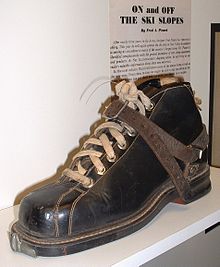History of skiing
The earliest archaeological examples of skis were found in Karelia (a region in western Russia on the border with Finland) and date to 6000 BCE.
In the 20th century it was practiced in snow-covered regions worldwide, providing a market for the development of ski resorts and their related communities.
Two regions present the earliest evidence of skis and their use: northern Russia, where the oldest fragments of ski-like objects, dating from about 6300–5000 BCE were found about 1,200 km northeast of Moscow at Lake Sindor,[8] and the Altaic region of modern China where 5000-year-old paintings suggest the aboriginal use of skis, though this is still highly debated.
A rock carving at Norway, from about 1000 or 500 BCE depicts a skier seemingly about to shoot with bow and arrow, with skis positioned in an angle (rather than parallel) to offer good support.
[10] 5000-year-old wall paintings suggest skiing had also evolved separately in the Xinjiang region by the Tuvan people; however, this continues to be debated.
[9][12][13] The first primitive Scandinavian ski was found in a peat bog in Hoting in Jämtland County in Sweden; it dates back to 4500 or 2500 BCE.
The arctic type was short and covered with fur, and used from northern Japan in the east to Ob river in the west.
The central Nordic type also had one short with fur (the andor) and one long, and was used in large parts of Norway, Sweden and Finland.
[22] Paulus Diaconus mentioned what may have been Sami and described how they chased animals by a twisted piece of wood that they painstakingly shaped to resemble a bow.
[15] Egil Skallagrimsson's 950 CE saga describes King Haakon the Good's practice of sending his tax collectors out on skis.
[21] Ski warfare, the use of ski-equipped troops in war, is first recorded by the Danish historian Saxo Grammaticus in the 13th century.
Swedish writer Olaus Magnus's 1555 A Description of the Northern Peoples describes skiers and their climbing skins in Scricfinnia in what is now Norway.
A 1593 inventory of the "choicest rarities" on display at the Leiden University included:[27] A Pair of Stilts or Skates, with which the Norwegians, Laplanders, and Finlanders run down high snawy mountaines with almost an incaepible swift pace.
In 1799, French traveler Jacques de la Tocnaye visited Norway and wrote in his travel diary:[28] In winter, the mail is transported through Filefjell mountain pass by a man on a kind of snow skates moving very quickly without being obstructed by snowdrifts that would engulf both people and horses.
The day will surely come when even those of other European nations are learning to take advantage of this convenient and cheap mode of transport.Norwegian immigrants used skis ("Norwegian snowshoes") in the US Midwest from around 1836.
Norwegian workers on the Buenos Aires - Valparaiso railway line introduced skiing in South America around 1890.
[21] In the First World War, Austro-Hungarian troops on the Italian front used skis and wore snow camouflage smocks and overtrousers over their uniforms.
The design included steel edges (invented in 1928 in Austria,[66]) and the exterior surfaces were made of phenol formaldehyde resin which could hold wax.
Other companies quickly followed suit, and it was realized in retrospect that "It turns out that everything we thought we knew for forty years was wrong.
[70] In the early days of skiing the binding was also similar to those of a contemporary snowshoe, generally consisting of a leather strap fastened over the toe of the boot.
[71] The cable binding remained in use, and even increased in popularity, throughout this period as cross-country skiing developed into a major sport of its own.
In 1937, Hjalmar Hvam broke his leg skiing, and while recuperating from surgery, invented the Saf-Ski toe binding.
[75] Boots with the sole extended rearward to produce a flange for the cable to firmly latch became common, as did designs with semi-circular indentations on the heel for the same purpose.
Johannes Scheffer in Argentoratensis Lapponiæ ("History of Lapland") in 1673 probably gave the first recorded instruction for ski wax application[76] He advised skiers to use pine tar pitch and rosin.
Wax does not stick to aluminum, so the base under the foot included grips to prevent backsliding, a precursor of modern fish scale waxless skis.
[67] Klister, a sticky material, which provides grip on snow of all temperatures that has become coarse-grained as a result of multiple freeze-thaw cycles or wind packing, was invented and patented in 1913 by Peter Østbye.
These designs were deemed too heavy, and following the conclusion of World War II, it became much more common to make the baskets out of some plastic material, a practice which has continued until today.
Cross country and freestyle skiing utilize much longer, straight poles, so as to make it easier for the skier to reach the ground while traversing the mountain.
Created by Bob Smith, an orthodontist from Sun Valley, Utah, these goggles allowed for air flow behind the lens in order to limit fogging and improve the skier's vision.
Despite these findings and analysis, in 1984, shortly after the passing of these regulations, it was found that "the mix of lens materials was approximately 78% glass, 11% plastic, and 11% polycarbonate.










